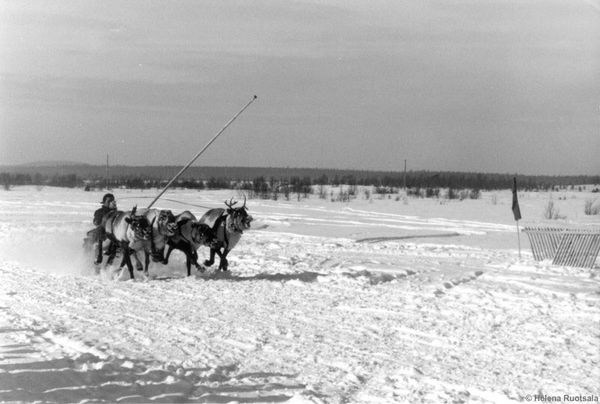Prasnik Severa, North festival in Kola peninsula
Prasnik Severa, Pohjolan juhla
Juhlat ovat areena, jossa etnistä identiteettistä ja etnistä yhteenkuuluvuutta voidaan ilmaista sekä itselle että toisille. Kuolan niemimaalla on vietetty Prasnik Severaa, Pohjolan juhlaa jo 1930-luvulta lähtien. Näissä juhlissa kansallisuus oli muutettu folkloristiseksi käärepaperiksi ja tehty vaarattomaksi. Juhlien ohjelman sisältö oli sosialistisen ideologian mukaista. Kansallisten vähemmistöjen omien laulujen, runojen ja tanssien esittäminen oli sallittua estradifolklorea.
Prasnik Severan ohjelmaan kuuluu poroajokilpailuja, suopunginheittokilpailuja, hiihtokilpailuja sekä myös käsityönäyttelyitä. Kylät, joissa poronhoitoa on harjoitettu pitivät ensin omat kilpailunsa, joista parhaimmat valittiin edustamaan omaa yhteisöä ensin Luujärvelle ja sitten myöhemmin Murmanskiin. Kilpailuihin osallistuttiin kolhoosin ja sovhoosin nimissä. Myös lapsille ja naisille oli omat kilpasarjansa. Porolla kilpailtiin sekä sani- eli rekisarjassa että suksisarjassa, ts. poro vetää suksilla olevaa kilpailijaa, jonka kädessä on ohjaussauva, horei.
Yhteisön jäsenet pukeutuvat juhlia varten omiin kansanpukuihinsa, saamelaiset omiinsa ja komit omiinsa. Luujärvellä 1990-luvun juhlissa näkyvillä oli myös Saamen lippu; tosin samassa salossa Venäjän lipun kanssa. 1990-luvulla juhlien ohjelmassa oli myös konsertteja ja sinne tuli vieraaksi Pohjoismaiden saamelaisia.
Sisällysluettelo: Tapakulttuuri ja kansanluonne
Prasnik Severa, North festival in Kola peninsula
This festival provides a forum for the peoples of the Kola Peninsula to express their ethnic identity and solidarity to themselves and others. It has been held ever since the 1930s. During the communist period, the notion of nationhood that lay behind this festival was rendered innocuous and transformed into a folkloristic wrapping, and the contents were made to fit socialist ideology. The performance of the songs, poems and dances of national minorities was permitted only as a form of music hall entertainment.
The festival programme included reindeer and ski races, lasso-throwing competitions and handicraft exhibitions. The villages in which reindeer husbandry was practised first held their own local trials to select their best representatives for competitions first in Lovozero and then in Murmansk. The competitions were between collective (kolkhoz) and state (sovkhoz) farms. There were also separate competitions for women and children. In the reindeer races, the animals either pulled a sledge (sani) or a competitor on skis, who guided the reindeer with a rod (horei).
The members of the communities, Saamis and Komis, each wear their own national costumes for the event. At the festivals in Lovozero in the 1990s, the Saami flag was also flown, admittedly from the same pole as the Russian flag. There were also concerts with visitors and visiting performers from the Nordic countries in the festival programme in the 1990s.
